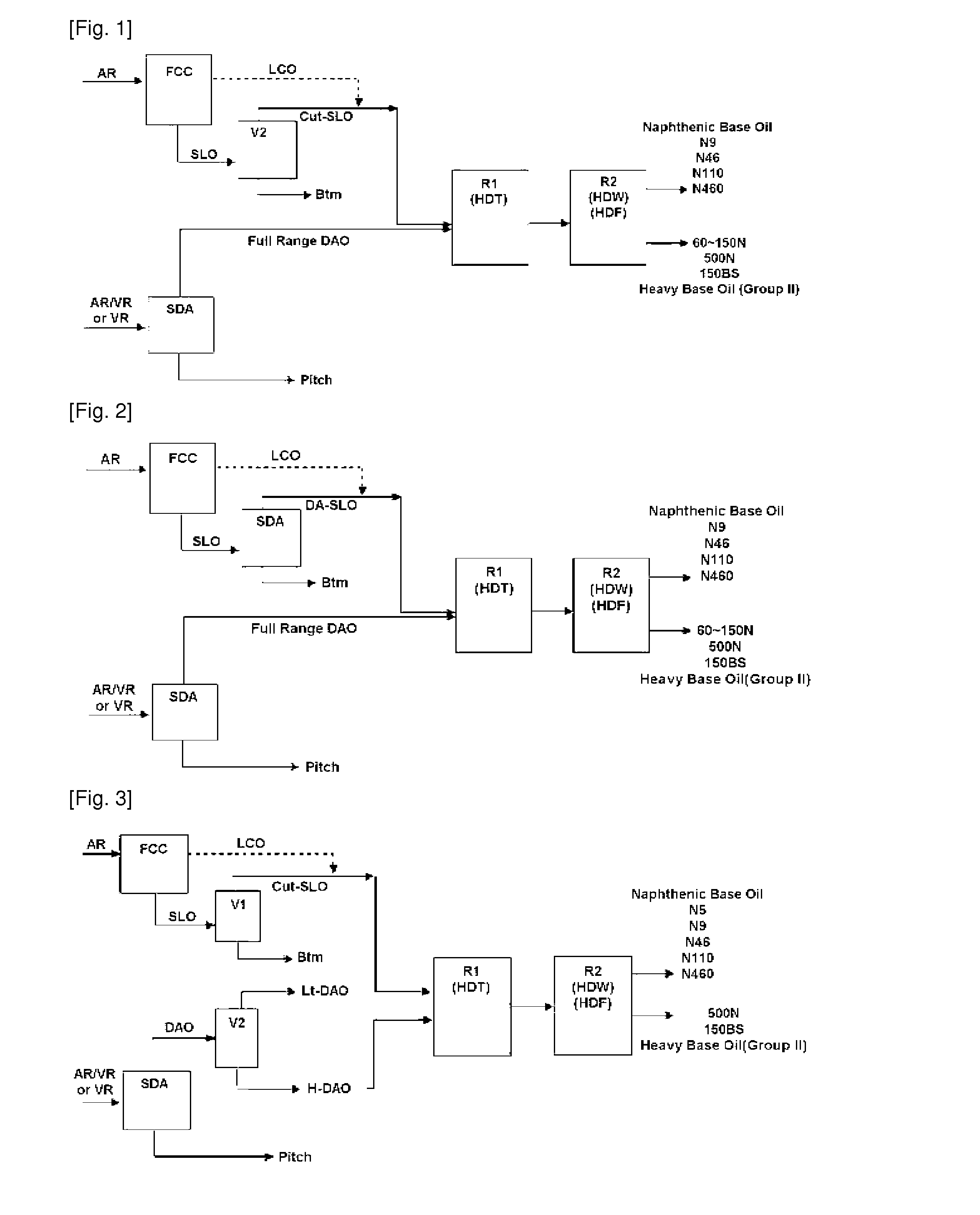Method of simultaneously manufacturing high quality naphthenic base oil and heavy base oil
- Summary
- Abstract
- Description
- Claims
- Application Information
AI Technical Summary
Benefits of technology
Problems solved by technology
Method used
Image
Examples
example 1
Manufacture of Base oil from Effluent of FCC
[0053]Among Cut-SLO fractions of Table 1, Cut-1 and Cut-2 were mixed at a volume ratio of 6:4 thus preparing a feedstock, which was then subjected to HDT under conditions including an LHSV of 0.5 hr−1, a pressure of 150 kg / cm2g, a reaction temperature of 370° C. and a hydrogen to oil ratio of 1500 NL / L in the presence of a commercially available catalyst having activities of hydrodesulfurization (HDS), hydrodenitrogenation (HDN) and hydrodemetallization (HDM), so that sulfur and nitrogen were reduced to 100 ppm or less and 10 ppm or less, respectively.
[0054]Subsequently, the oil fraction obtained after HDT was subjected to Catalytic dewaxing (CDW) unit using an isomerization catalyst comprising Pt / zeolite and to HDF using an HDF catalyst composed of (Pt / Pd) / Al2O3. The CDW and HDF were performed under conditions including a reaction pressure of 140˜150 kg / cm2g, an LHSV of 1.0˜2.0 hr−1, and a hydrogen to oil ratio of 400˜600 Nm3 / m3. As such,...
example 2
Manufacture of Base Oil from Effluent (H-DAO subjected to Vacuum Distillation) of SDA
[0057]Heavy base oil (500N / 150BS or the like) was manufactured at high yield under the same (single) catalyst / process conditions as when manufacturing the naphthenic base oil from Cut-SLO. Specifically, heavy deasphalted oil (H-DAO) shown in Table 2 was subjected to HDT under conditions including an LHSV of 0.5˜1.0 hr−1, a pressure of 150 kg / cm2g, a reaction temperature of 350˜360° C. and a hydrogen to oil ratio of 1,000˜1500 NL / L in the presence of a commercially available catalyst having activities of HDS, HDN and HDM, so that sulfur and nitrogen were reduced to 50 ppm or less and 5 ppm or less, respectively.
[0058]Subsequently, the oil fraction obtained after HDT was subjected to CDW using an isomerization catalyst comprising Pt / zeolite and to HDF in the presence of an HDF catalyst composed of (Pt / Pd) / Al2O3. The reaction was performed under conditions including a reaction pressure of 140˜150 kg / cm...
example 3
Manufacture of Base Oil from Effluent (DAO not subjected to Vacuum Distillation) of SDA
[0061]Base oil was manufactured from DAO (not subjected to vacuum distillation) under the same (single) catalyst / process conditions as when manufacturing the naphthenic base oil and heavy base oil from Cut-SLO and H-DAO. Specifically, Full Range DAO shown in Table 2 was subjected to HDT under conditions including an LHSV of 0.5˜1.0 hr−1, a pressure of 150 kg / cm2g, a reaction temperature of 350˜360° C. and a hydrogen to oil ratio of 1,000˜1500 NL / L in the presence of a commercially available catalyst having activities of HDS, HDN and HDM, so that sulfur and nitrogen were reduced to 50 ppm or less and 5 ppm or less, respectively.
[0062]Subsequently, the oil fraction obtained after HDT was subjected to CDW using an isomerization catalyst comprising Pt / zeolite and to HDF in the presence of an HDF catalyst composed of (Pt / Pd) / Al2O3. The reaction was performed under conditions including a reaction pressu...
PUM
| Property | Measurement | Unit |
|---|---|---|
| Temperature | aaaaa | aaaaa |
| Kinematic viscosity | aaaaa | aaaaa |
| Kinematic viscosity | aaaaa | aaaaa |
Abstract
Description
Claims
Application Information
 Login to View More
Login to View More - R&D
- Intellectual Property
- Life Sciences
- Materials
- Tech Scout
- Unparalleled Data Quality
- Higher Quality Content
- 60% Fewer Hallucinations
Browse by: Latest US Patents, China's latest patents, Technical Efficacy Thesaurus, Application Domain, Technology Topic, Popular Technical Reports.
© 2025 PatSnap. All rights reserved.Legal|Privacy policy|Modern Slavery Act Transparency Statement|Sitemap|About US| Contact US: help@patsnap.com


